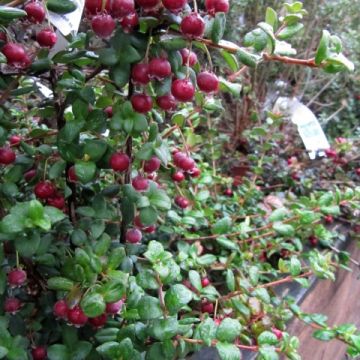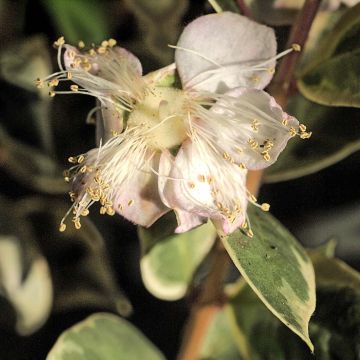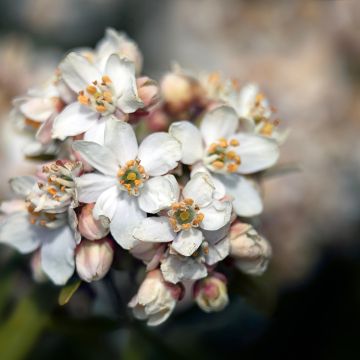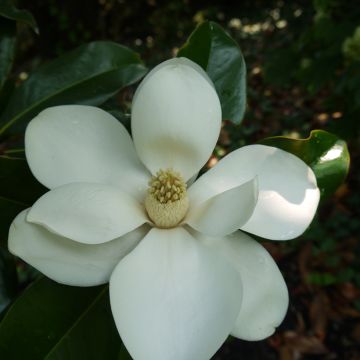

Myrtus ugni - Myrte ugni
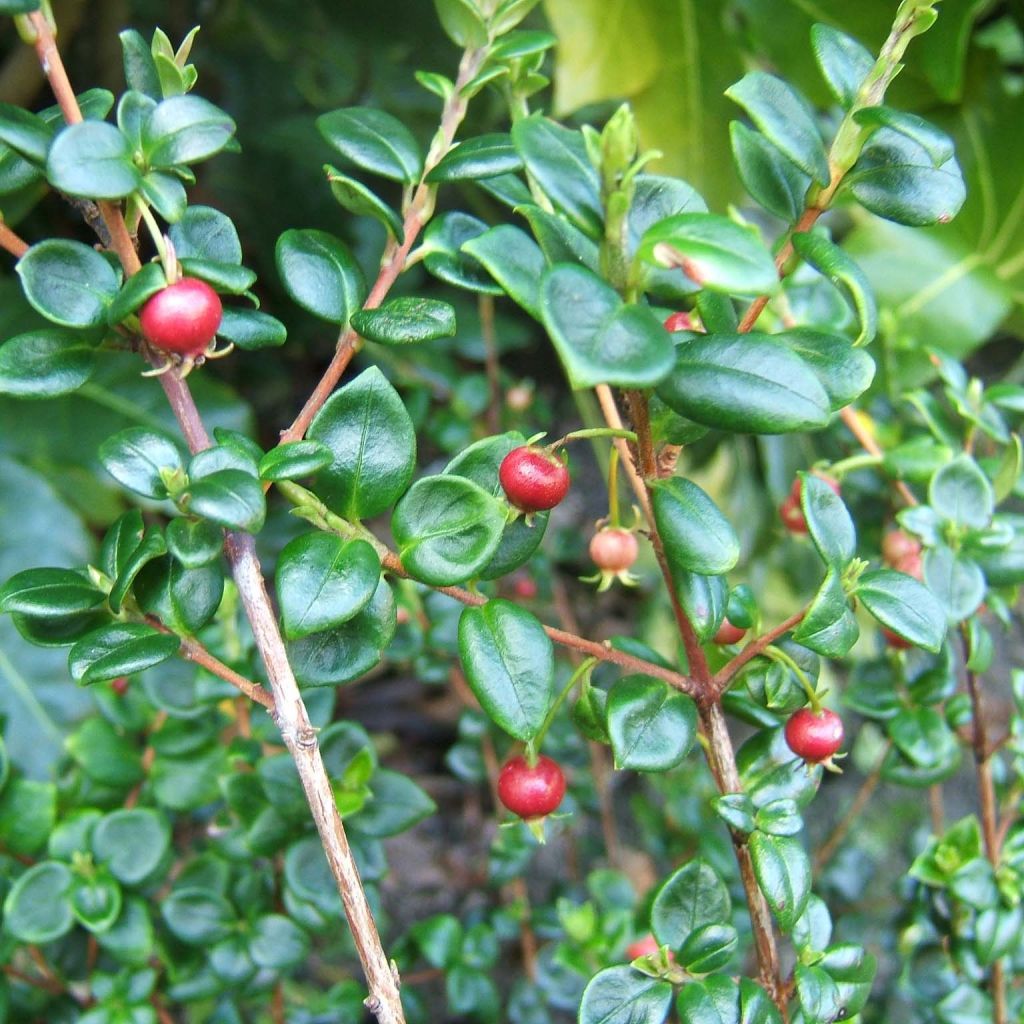

Myrtus ugni - Myrte ugni
Myrtus ugni
Myrtus ugni
Strawberry myrtle, Chilean guava, Ugni, New Zealand cranberry
Why not try an alternative variety in stock?
View all →This plant carries a 24 months recovery warranty
More information
We guarantee the quality of our plants for a full growing cycle, and will replace at our expense any plant that fails to recover under normal climatic and planting conditions.
From €5.90 for pickup delivery and €6.90 for home delivery
Express home delivery from €8.90.
Delivery to Corse prohibited: UE law prohibits the import of this plant from mainland France to Corse as part of the fight against Xylella fastidiosa. Please accept our sincere apologies.
More information
Does this plant fit my garden?
Set up your Plantfit profile →
Description
Myrtus ugni, also known as Ugni molinae, Eugenia ugni, or Chilean Guava, is a small evergreen bush native to South America that is well adapted to our mild oceanic regions, where it will produce delicious small fruits reminiscent of wild strawberries. They were said to be a favourite of Queen Victoria. This somewhat tender plant remains largely underutilised in our gardens, although its cultivation presents no difficulties. Its late spring flowering of small, pink, bell-shaped blooms, emerges on small, glossy, elegant, highly aromatic foliage that is decorative all year round. Plant in cool, well-drained soil with no excess of limestone, in full sun or partial shade, either in the ground or in a large pot.
Myrtus ugni is a small bush that reaches 2m (7ft) in height in its natural environment, but rarely exceeds 1.1m (4ft) in all directions in our climates. It belongs to the Myrtaceae family, which is found in the wild in Chile, Bolivia, and Argentina, on the irrigated slopes of the Andes and not far from rivers. In Europe, the finest specimens grow in Irish gardens.
Its growth rate is slow, and its habit is naturally dense, ramified, slightly spreading, and very bushy. The evergreen leaves are shiny, ovate, and leathery. They emit a fragrance of strawberry and spice when crushed. They are initially purple before becoming dark green, and measure no more than 1.5cm (1in) long and 1cm (0.4in) wide. The bush is self-fertile and highly attractive to bees. It flowers generously in June. The small, globular, white to pink, fragrant flowers have 4 to 5 petals which are 1cm (0.4in) wide. They appear in the axils of the leaves, on the current year's shoots, and are followed in autumn by the formation of small, round, fleshy, edible, and aromatic fruits, from September to November. The fruits are initially dark red, lightening as they ripen. Their sweet flavour is reminiscent of wild strawberries, guava, and kiwi, and is enhanced by a resinous and spicy note. They can be eaten raw, used in jam or pastries, and are used in the production of a Chilean liqueur called Murtado.
Hardy to approximately -8°C (17.6°F), Myrtus ugni is an ornamental plant that is both charming and delicious in cold climates. In a greenhouse or conservatory, it will create an extremely decorative quartet with an orange tree, a Yuzu, and a mimosa, evoking landscapes with exotic charms and scents. In mild climates, it can be used as a low hedge - it tolerates pruning well - or in a flower bed, or even in a well-sheltered orchard, alongside blueberries, raspberries, and the May Berry. It can also be planted in an evergreen hedge, accompanied by a sarcococca, a spring-flowering broom, and dwarf rhododendrons in non-limestone soil, or red-flowered callistemons (Callistemon citrinus 'Splendens').
Report an error about the product description
Myrtus ugni in pictures
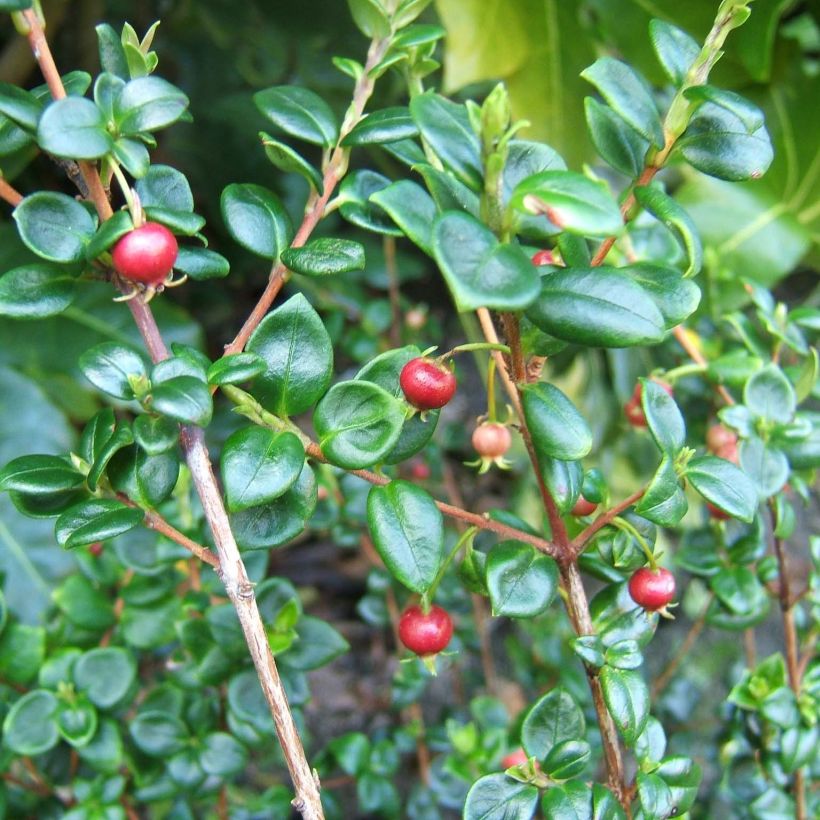

Plant habit
Flowering
Foliage
Botanical data
Myrtus
ugni
Myrtaceae
Strawberry myrtle, Chilean guava, Ugni, New Zealand cranberry
South America
Other Myrtus - Myrtle
Planting and care
It thrives in light, non or low-calcareous, well-drained but moist soil. It needs moist soil in summer. It is tolerant of temporary drought once well established. Flowering and fruiting will be greatly impacted by a lack of water. Loose soil, whether humiferous, slightly rocky or sandy, slightly acidic, neutral or even very slightly calcareous will do. It tolerates sea spray well. Plant it after the last frost in cool regions, and in September-October in warmer climates. It will flourish in full sun or partial shade and likes to have warm roots. Under these conditions, it is hardy down to -7 or -8°C (19.4 or 17.6°F), and can live for many years. Surround it with a winter cover in colder regions, and isolate it from the cold as much as possible. Place it in the warmest corner of the garden, in full sun against a south-facing wall. However, in regions away from the sea, it should be grown in a large pot to overwinter in a bright but unheated room. To shape it, you can prune the stems in March-April or after flowering to encourage the plant to branch out.
Container gardening:
Ensure good drainage at the bottom of the pot, which should be of large volume. Use a light substrate, enriched with leaf compost, and apply a little slow-release fertiliser in late winter and autumn. Water generously in summer, allowing the soil to dry out a little between waterings. The more you water, the more your myrtle will flower and fruit. This self-fertile variety does not require the presence of another plant nearby to bear fruit.
Planting period
Intended location
Care
This item has not been reviewed yet - be the first to leave a review about it.
Evergreen shrubs
Haven't found what you were looking for?
Hardiness is the lowest winter temperature a plant can endure without suffering serious damage or even dying. However, hardiness is affected by location (a sheltered area, such as a patio), protection (winter cover) and soil type (hardiness is improved by well-drained soil).

Photo Sharing Terms & Conditions
In order to encourage gardeners to interact and share their experiences, Promesse de fleurs offers various media enabling content to be uploaded onto its Site - in particular via the ‘Photo sharing’ module.
The User agrees to refrain from:
- Posting any content that is illegal, prejudicial, insulting, racist, inciteful to hatred, revisionist, contrary to public decency, that infringes on privacy or on the privacy rights of third parties, in particular the publicity rights of persons and goods, intellectual property rights, or the right to privacy.
- Submitting content on behalf of a third party;
- Impersonate the identity of a third party and/or publish any personal information about a third party;
In general, the User undertakes to refrain from any unethical behaviour.
All Content (in particular text, comments, files, images, photos, videos, creative works, etc.), which may be subject to property or intellectual property rights, image or other private rights, shall remain the property of the User, subject to the limited rights granted by the terms of the licence granted by Promesse de fleurs as stated below. Users are at liberty to publish or not to publish such Content on the Site, notably via the ‘Photo Sharing’ facility, and accept that this Content shall be made public and freely accessible, notably on the Internet.
Users further acknowledge, undertake to have ,and guarantee that they hold all necessary rights and permissions to publish such material on the Site, in particular with regard to the legislation in force pertaining to any privacy, property, intellectual property, image, or contractual rights, or rights of any other nature. By publishing such Content on the Site, Users acknowledge accepting full liability as publishers of the Content within the meaning of the law, and grant Promesse de fleurs, free of charge, an inclusive, worldwide licence for the said Content for the entire duration of its publication, including all reproduction, representation, up/downloading, displaying, performing, transmission, and storage rights.
Users also grant permission for their name to be linked to the Content and accept that this link may not always be made available.
By engaging in posting material, Users consent to their Content becoming automatically accessible on the Internet, in particular on other sites and/or blogs and/or web pages of the Promesse de fleurs site, including in particular social pages and the Promesse de fleurs catalogue.
Users may secure the removal of entrusted content free of charge by issuing a simple request via our contact form.
The flowering period indicated on our website applies to countries and regions located in USDA zone 8 (France, the United Kingdom, Ireland, the Netherlands, etc.)
It will vary according to where you live:
- In zones 9 to 10 (Italy, Spain, Greece, etc.), flowering will occur about 2 to 4 weeks earlier.
- In zones 6 to 7 (Germany, Poland, Slovenia, and lower mountainous regions), flowering will be delayed by 2 to 3 weeks.
- In zone 5 (Central Europe, Scandinavia), blooming will be delayed by 3 to 5 weeks.
In temperate climates, pruning of spring-flowering shrubs (forsythia, spireas, etc.) should be done just after flowering.
Pruning of summer-flowering shrubs (Indian Lilac, Perovskia, etc.) can be done in winter or spring.
In cold regions as well as with frost-sensitive plants, avoid pruning too early when severe frosts may still occur.
The planting period indicated on our website applies to countries and regions located in USDA zone 8 (France, United Kingdom, Ireland, Netherlands).
It will vary according to where you live:
- In Mediterranean zones (Marseille, Madrid, Milan, etc.), autumn and winter are the best planting periods.
- In continental zones (Strasbourg, Munich, Vienna, etc.), delay planting by 2 to 3 weeks in spring and bring it forward by 2 to 4 weeks in autumn.
- In mountainous regions (the Alps, Pyrenees, Carpathians, etc.), it is best to plant in late spring (May-June) or late summer (August-September).
The harvesting period indicated on our website applies to countries and regions in USDA zone 8 (France, England, Ireland, the Netherlands).
In colder areas (Scandinavia, Poland, Austria...) fruit and vegetable harvests are likely to be delayed by 3-4 weeks.
In warmer areas (Italy, Spain, Greece, etc.), harvesting will probably take place earlier, depending on weather conditions.
The sowing periods indicated on our website apply to countries and regions within USDA Zone 8 (France, UK, Ireland, Netherlands).
In colder areas (Scandinavia, Poland, Austria...), delay any outdoor sowing by 3-4 weeks, or sow under glass.
In warmer climes (Italy, Spain, Greece, etc.), bring outdoor sowing forward by a few weeks.


































